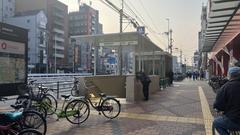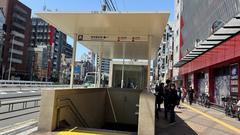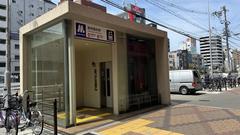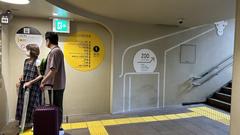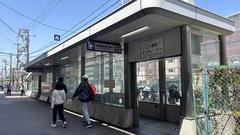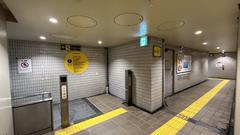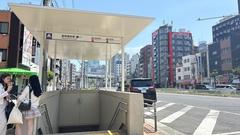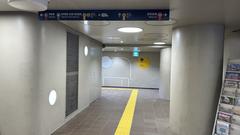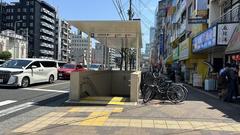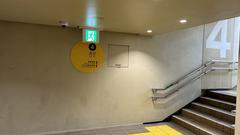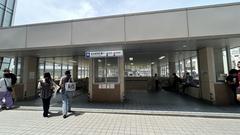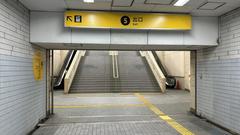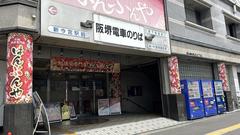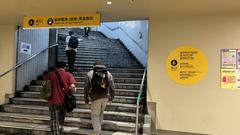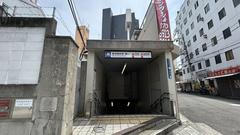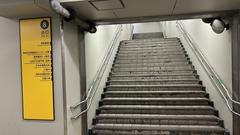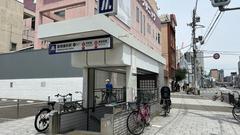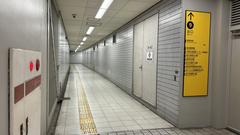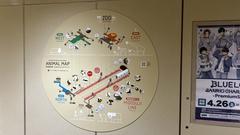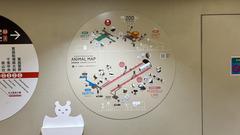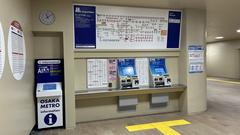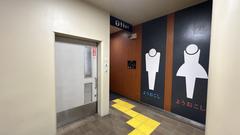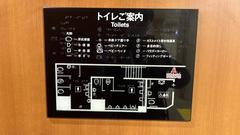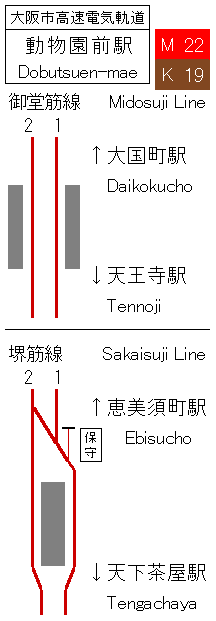
Dōbutsuen-Mae Station Osaka: Complete Guide to Visiting Hours, Tickets, and Historical Sites
Date: 14/06/2025
Introduction: Dōbutsuen-Mae Station’s Role in Osaka
Dōbutsuen-Mae Station stands as a vibrant gateway to southern Osaka, seamlessly blending transit convenience with the city’s historical and cultural essence. Located in Nishinari-ku, the station is named for its proximity to Tennōji Zoo, one of Japan’s oldest zoological parks, and serves as a crucial interchange between the Osaka Metro Midosuji and Sakaisuji Lines. Beyond its role as a transportation hub, Dōbutsuen-Mae invites visitors to explore neighborhoods rich in nostalgia and tradition—such as Shinsekai, with its iconic Tsutenkaku Tower and lively street food scene, and Tennoji, home to ancient temples and lush urban parks.
This comprehensive guide provides all the essential information for travelers: visiting hours, ticketing options, accessibility features, and a curated list of the best nearby attractions. Whether you want to photograph the station’s whimsical animal-themed pillars, sample local kushikatsu, or take in city views from Tsutenkaku, this resource ensures a smooth and memorable visit. For the latest updates, consult the Osaka Metro website and the Tennōji Zoo official site.
Contents
- Introduction
- History and Cultural Significance
- Station Location and Lines
- Visiting Hours
- Ticketing Information
- Ticket Types and Prices
- Purchasing Tickets
- Transfers
- Station Layout and Design
- Accessibility and Passenger Facilities
- Safety and Security
- Station Exits and Navigation
- Nearby Attractions and Connections
- Tennōji Zoo
- Shinsekai District & Tsutenkaku Tower
- Spa World
- Tennoji Park & Shitennoji Temple
- Other Notable Areas
- Practical Travel Tips
- Special Events and Tours
- Seasonal Highlights
- FAQ
- Conclusion
- Sources
History and Cultural Significance
Dōbutsuen-Mae Station, meaning “in front of the zoo,” honors its proximity to Tennōji Zoo, a symbol of Osaka’s modernization since the Taisho era. The surrounding Nishinari district flourished alongside Osaka’s rise as a commercial center and retains its unique character through postwar reconstruction and ongoing urban transformation. Shinsekai, adjacent to the station, is a nostalgic district established in 1912, famed for its retro charm and the landmark Tsutenkaku Tower—a beacon of entertainment and local pride (Inside Osaka).
Station Location and Lines
Dōbutsuen-Mae Station sits at 34°38′56″N 135°30′16″E (Wikipedia), connecting the Osaka Metro Midosuji Line (M22, red) and Sakaisuji Line (K19, brown). It’s a critical transit point for reaching southern Osaka’s attractions. The nearby Shin-Imamiya Station, operated by JR West and Nankai Electric Railway, is a brief walk away and provides additional access to regional and airport lines (Osaka Metro official; Commute Tour Japan).
Visiting Hours
- Dōbutsuen-Mae Station: Daily, 5:00 AM–midnight (may vary slightly by line)
- Tennōji Zoo: 9:30 AM–5:00 PM (last admission 4:00 PM), closed Mondays (or next business day if Monday is a holiday)
- Tsutenkaku Tower: 9:00 AM–9:00 PM (last admission 8:30 PM)
- Spa World: 10:00 AM–8:45 AM the next day
- Tennoji Park: 5:00 AM–11:00 PM
(Osaka Metro official), (Tennōji Zoo official site), (Tsutenkaku Official Site), (Spa World Official Site)
Ticketing Information
Ticket Types and Prices
- Single Tickets: Start at ¥180, fare varies with distance
- IC Cards: ICOCA, PiTaPa, Suica, and Pasmo are accepted for tap-in/tap-out travel
- Day Passes: The Enjoy Eco Card and other tourist day passes offer unlimited rides on Osaka Metro and buses (Osaka.com)
Purchasing Tickets
- Multilingual ticket machines accept cash and IC card top-ups
- Staffed customer service booths provide assistance with ticketing, fare calculations, and lost-and-found (MetroEasy)
Transfers
- Transfers between Midosuji and Sakaisuji lines can be made within the paid area
- Transfers to Shin-Imamiya Station require exiting and purchasing a separate ticket
Station Layout and Design Features
Dōbutsuen-Mae Station is a multi-level underground facility:
- Midosuji Line Platforms: Lower level, two side platforms for trains toward Nakamozu and Umeda
- Sakaisuji Line Platforms: Separate level with side platforms for northbound and southbound service
The station is famous for its playful “butt columns”—pillars decorated with animal rear illustrations as a nod to the nearby zoo, making a quirky photo opportunity (As Seen In Japan). Modern interiors feature bright lighting, clear signage, and LCD screens with bilingual information.
Accessibility and Passenger Facilities
Dōbutsuen-Mae Station is fully accessible:
- Elevators, Escalators, and Tactile Paving: Connect all levels and help guide visually impaired travelers
- Barrier-Free Restrooms: Equipped for wheelchairs, with baby-changing and nursing facilities
- Coin Lockers: Small (¥300), medium (¥400), large (¥600–¥700 per 24 hours)
- AEDs and First Aid: Available on-site
- Free Wi-Fi: “Osaka Free Wi-Fi” is accessible throughout the station
Safety and Security
- Platform Safety Lines & Signage
- Security Cameras & Emergency Call Boxes
- Women-Only Cars: Designated boarding areas during weekday morning rush hours
Station Exits and Area Navigation
- Exit 1: Closest to Tennōji Zoo and the Shinsekai district
- Exit 2: Leads toward Tsutenkaku Tower and Shin-Imamiya
- Other Exits: Connect to shopping arcades, bus stops, and local neighborhoods
Area maps and bilingual signage are provided for easy navigation (Osaka Metro station map PDF).
Nearby Attractions and Connections
Tennōji Zoo
A short walk from Exit 1, Tennōji Zoo (est. 1915) features over 1,000 animals in themed habitats like the African Savanna and Asian Forest. It’s family-friendly, educational, and fully wheelchair accessible (Live Japan).
Shinsekai District & Tsutenkaku Tower
Shinsekai’s neon-lit streets, affordable eateries, and retro Showa-era vibe offer a true taste of old Osaka. Sample kushikatsu (deep-fried skewers) and take in panoramic city views from Tsutenkaku Tower’s observatory. Don’t miss the Billiken statue—a local good luck symbol (Seeing Japan), Tsutenkaku Official Site).
Spa World
This expansive onsen theme park features global-themed baths, water slides, saunas, and relaxation areas. It’s open for overnight stays and is accessible to families and wheelchair users (Spa World Official Site).
Tennoji Park & Osaka City Museum of Fine Arts
A serene green space with seasonal gardens, ponds, and walking paths. The museum features Japanese and East Asian art and is open 9:30 AM–5:00 PM (last entry 4:30 PM), closed Mondays (Seeing Japan).
Shitennoji Temple
One of Japan’s oldest Buddhist temples, established in 593 AD, with a five-story pagoda and treasure house. Open 8:30 AM–4:30 PM; some areas charge a small admission fee. Look out for monthly festivals and flea markets (TripSavvy).
Other Notable Areas
- Tobita Shinchi: Osaka’s historic entertainment district. Guided walking tours available; observe local customs (Pleasure in Japan).
- Namba & Dotonbori: The city’s entertainment epicenter, with vibrant lights, shopping, and canal views (TripSavvy).
- Kuromon Ichiba Market: Osaka’s “walk-and-eat paradise” for fresh seafood and street food (Seeing Japan).
- Den Den Town: Paradise for anime, manga, and electronics enthusiasts (TripSavvy).
- Ura-Namba: Hip backstreets with izakayas and local bars (Seeing Japan).
Practical Travel Tips
- Navigation: Use the Osaka Metro Midosuji and Sakaisuji Lines for direct access to major districts (Inside Osaka).
- Best Visit Times: Weekdays and mornings are less crowded.
- Weather: June is rainy (25–27°C); carry an umbrella (Japan Highlights).
- Cash: Many local eateries are cash only.
- Accessibility: Most major attractions and the station are wheelchair-friendly.
- Safety: Generally safe, but exercise caution at night in entertainment districts.
Special Events and Tours
Nearby attractions frequently host seasonal festivals, illumination events, and guided tours. Refer to official websites for schedules and booking details.
Seasonal Highlights
- June: Hydrangeas bloom in Tennoji Park; early summer festivals abound, even during the rainy season (Japan Highlights).
- Autumn: Vibrant foliage in parks and food festivals across Shinsekai and Tennoji (Seeing Japan).
Frequently Asked Questions (FAQ)
Q: What are Dōbutsuen-Mae Station’s operating hours?
A: 5:00 AM–midnight daily.
Q: How much are tickets for Tennōji Zoo?
A: ¥500 for adults, ¥200 for children.
Q: Is the area wheelchair accessible?
A: Yes, the station and most attractions are accessible.
Q: Are guided tours available?
A: Yes, especially for Shinsekai and Tobita Shinchi—book through reputable local operators.
Q: Can I use Suica/Pasmo IC cards?
A: Yes, major IC cards are accepted.
Q: Where are the best photo spots?
A: Tsutenkaku Tower, Shinsekai’s retro streets, and the animal-themed columns in the station.
Conclusion
Dōbutsuen-Mae Station is more than a subway stop—it is your portal to Osaka’s rich tapestry of history, culture, and entertainment. With its playful design, accessibility, excellent connections, and proximity to some of the city’s most compelling neighborhoods and attractions, it provides a memorable starting point for any Osaka adventure. Plan ahead, utilize local resources, and immerse yourself in the authentic experiences this district offers.
For real-time updates, personalized guides, and exclusive offers, download the Audiala app and follow us on social media. Explore more through our related articles on Osaka Metro lines and historical sites to make the most of your visit.
Sources
- This guide references official and reputable sources for accuracy. For further reading and up-to-date information, consult:
- Tennōji Zoo official site
- Osaka Metro official station guide
- Inside Osaka
- Osaka Metro Sakaisuji Line station guide
- Tsutenkaku Official Site
- Spa World Official Site
- TripSavvy: Best Osaka Neighborhoods
- Seeing Japan: Shinsekai Guide
- Rome2Rio: Dōbutsuen-Mae Station to Osaka Station
- MetroEasy: Osaka Municipal Subway
- Audiala App

